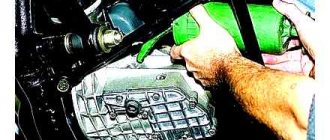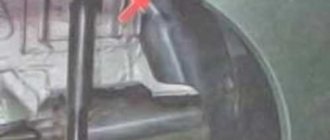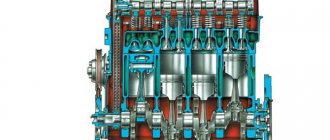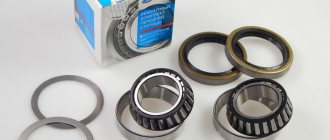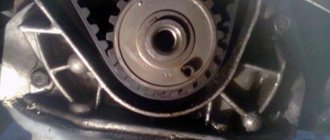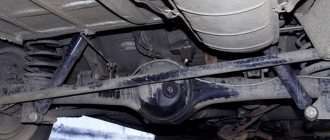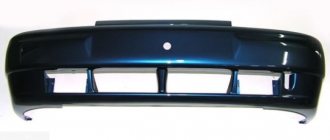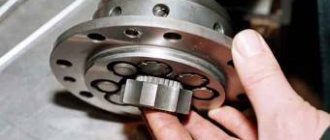Chassis features
The VAZ Niva 2121 (21213, etc.) has both drive axles, which allows the car to efficiently overcome off-road conditions or muddy roads. Engine power is transmitted to each wheel through gearboxes. Niva has two of them: rear driven and front driven/steered.
These nodes are considered one of the most “painful”. If the car is actively used in extreme conditions, the first breakdown will occur at approximately 100,000 km. The modern market and service offer to immediately buy a new node. However, repairs are quite accessible with your own hands.
Definition of failure
A broken gearbox, like any other component, has specific signs of a defect. A competent auto mechanic can easily determine even the specific type of problem. An ordinary car owner should also know these signs so as not to spend money on car services. An audible way to determine gearbox damage:
- You should choose a road with the highest quality surface without traffic. You need to gradually accelerate to 90 km/h and brake smoothly. At this time, record the appearance of extraneous noise. Repeat the acceleration to 90 km/h, turn off the engine and listen while rolling. If the sound is different, then a breakdown is quite possible.
- Put the car on the hand (parking) brake, start the engine and gradually increase the speed in neutral gear. If the noises match the first test, then the gearbox is most likely normal.
A more accurate determination of the malfunction is possible on the lift when the wheels rotate freely. This method is best known to specialists from services. Using it requires experience and an understanding of what you need to hear.
Front axle gearbox
The front gearbox of Niva 21213 differs from the rear gearbox: location, mounting method and design. In order to dismantle it, you will have to lift the car. Further analysis proceeds according to the following scheme:
- Remove the front axle suspension extension (unscrew both fasteners).
- Unscrew the adjusting hub nut and remove the lower shock absorber mount.
- Install the stop and release the ball joint (lower) from the lever.
- Pull out the shank.
- Unscrew the engine support and the axle mounting.
- Unscrew the fastening of the inner joint bearing cap and crankcase bracket to the bridge.
- Pry off the cover and remove the housing from the gearbox.
- Using a support, separate it from the left engine bracket and the cylinder block. Remove the gearbox from the front axle mountings.
After this, you can disassemble the gearbox itself and accurately determine the nature of the damage.
Work process
So:
- It is necessary to disconnect the negative cable terminal from the corresponding terminal of the battery.
- Then you should unscrew all the spark plugs.
Note. When performing the following procedure (after removing the camshaft bearing housing), it is necessary to note the position of the actuator valve arms.
- Along with the camshaft, remove the bearing housing, as well as the springs and valve actuator arms. When dismantling the camshaft, the pistons of the fourth and first cylinders must be installed at TDC (top dead center). This measure will prevent the valve from falling into the valve cylinder after the first one has been dried out. In the top dead center position, the oil seals of the fourth and first cylinders are changed.
- Install a tin rod through the spark plug hole between the valve plate and the piston; its diameter should be about 8 millimeters.
Replacing valve stem seals on a VAZ 21213
- Install the depressurizer pressure bracket on the spring plate, using a nut that is screwed onto the camshaft bearing housing fastener pin, secure the support bracket.
- Afterwards, you need to compress the valve spring using a desiccant, and then remove two crackers from the groove. Unscrew the fastening nut and remove the desiccant device.
- Remove the spring plate.
- Then you will need to remove the inner and outer springs.
- Next, you need to remove the valve inner spring support washer.
- Install the collet of the removable inertial device onto the oil deflector cap. To compress the collet, hit the upper striker against the lower one. Perform a crimp test of the oil deflector cap with the valve guide bushing; to perform this task, use the upper striker to strike the nut of the removable structure.
Valve stem seals
Note. Now let's talk about choosing oil seals. A large number of counterfeit caps are sold on car markets, and most of them are questionable in terms of quality, and replacing valve stem seals is not so easy. The oil seal must be reliable and of high quality; it has a difficult and responsible job.
- Firstly, it must allow oil to pass through so that it lubricates the valve stem, and secondly, it must not allow oil to enter the combustion chamber. Quality and its service life depend on the quality of materials and manufacturing precision. A valve seal made of low-quality rubber will very quickly harden and begin to leak oil, which will result in the release of bluish smoke from the exhaust pipe, and in addition, oil will appear on the spark plugs and subsequently they will have to be changed frequently. It won't do you any good to install valve seals of the wrong size. You need to choose those valve stem seals that have proven themselves to be the best, and most importantly, you need to make sure that the product you purchased is not a counterfeit.
- If the installation sleeve is included in the set of new oil seals, then it must be placed on the valve stem. This measure will make it possible to prevent damage to the working edge of the cap during installation.
- It is necessary to apply engine oil to the inner surface of the valve stem seal, and then move it down into the valve guide until it stops along the installation sleeve.
- Using the specialized mandrel included in the puller kit, press the oil scraper cap onto the valve guide.
- Reinstall the removed valve parts in reverse order.
- Pull out the tin rod and give a couple of light blows to the end face of the valve stem with a hammer. This is done so that the crackers sit in place.
Replacing the oil seals of the valve timing mechanism VAZ 21213
- Replace the oil seals in the remaining valves of the fourth and first cylinders in a similar way.
- Replace the oil seals of the third and second cylinders as you previously did on the fourth and first cylinders.
- After replacing the valve stem seals of the third and second cylinders, turn the engine crankshaft one and a half turns (540 degrees). This is required in order to set the piston of the fourth cylinder to the top dead center of the compression stroke.
- Install the camshaft assembly with the bearing housing on the engine cylinder head. And then you need to tighten the fastening nuts evenly.
- Untie the wire from the sprocket-pulley with the chain, install the sprocket on the camshaft (at this time there should be a timing chain on this sprocket). Then you need to tighten the fastening threaded element and lock it, for this you need to bend the petals of the lock washer of this bolt.
- Check if the marks match.
- Then you need to charge the tensioner of the timing mechanism of the drive chain, then put it in place, and then discharge it again.
- It is necessary to adjust the clearance in the valve drive.
- Perform further assembly in reverse order.
Also interesting: Chevrolet Niva cooling system
Also, if something is not clear to you or you want to study the process in more detail, then on the Internet there are a huge number of photos and videos of replacing valve stem seals on a VAZ 21213. In them you can study this process in detail. Although, in principle, there is nothing complicated about it no, you just need to start, do it and everything will work out. The main thing is to have all the necessary tools at hand.
Rear axle
A diagram of dismantling the unit will also be described below. Specific repairs to the rear axle gearbox of the VAZ 2121 Niva require specifics. It is simply impossible to briefly describe every possible malfunction and its elimination. Therefore, the diagram for removing the rear assembly is:
- Unscrew the axle shaft.
- Bend back the locking plates.
- Move the axle shaft.
- Remove the mounting bolts and remove the assembly.
As you can see, the rear assembly is much easier to remove. All that remains is to secure it on the workbench and disassemble it. However, you still need to remember that the part is very heavy and move it carefully.
Disassembling and assembling the transfer case
Drain the oil from the transfer case and clean it of dirt.
Loosen the drive shaft flange nut (see Replacing transfer case shaft seals).
Similarly, loosen the nuts of the other two flanges. We remove the speedometer drive gear housing (see Removing the speedometer drive gear housing and speed sensor of a VAZ-21214 car (vehicle speedometer drive gear housing)).
Using a 13mm socket, unscrew the five nuts of the front axle drive housing.
Using a screwdriver to pry the crankcase at the lugs,...
...let's take it off...
...and a gasket.
Using a screwdriver, pry off the lock washer...
... we take out the axis of the differential lock lever of the VAZ 2121 (if there is difficulty, we knock it out with a soft metal drift).
Remove the differential lock lever and the plastic axle bushings.
Remove the differential lock warning lamp switch (see Replacing the differential lock warning lamp switch).
Remove the lever spring from the differential lock fork rod.
Using a 13mm socket, unscrew the four nuts securing the front axle drive housing cover.
Remove the cover and gasket.
We take out the spring and shake out the retaining ball from the crankcase socket.
Using a 10mm spanner, unscrew the locking bolt of the differential lock clutch fork.
Remove the bolt and spring washer.
Use a screwdriver to pry off the protective cover of the differential lock fork rod...
...and take out the rod with the cover.
We take out the plug...
...and the differential lock clutch.
We completely unscrew the previously loosened flange nut and remove the washer.
Remove the flange.
Squeezing with pliers, remove the retaining ring of the front axle drive shaft bearing.
We remove the shaft assembly from the crankcase.
Also interesting: What kind of oil to pour into the transmission, transfer case and axles of Niva Chevrolet
Remove the oil deflector and thrust ring from the front end of the shaft.
Having hooked the outer ring of the bearing with a three-legged puller,...
...press the bearing.
Using a 13mm socket, unscrew the eight nuts securing the rear cover to the transfer case housing.
Prying it with a screwdriver...
...remove the cover assembly with the rear axle drive shaft...
...and a gasket.
We remove the rear axle drive shaft from the rear cover and disassemble it in the same way as the front crankcase shaft of the VAZ 2131.
Rear axle drive shaft parts and rear cover.
Using a 13mm wrench, unscrew the two nuts securing the gearshift lever bracket to the transfer case housing...
...and remove the gear shift bracket with the lever.
We disconnect the gear shift lever from the bracket in the same way as removing the differential lock lever. Having finally unscrewed the drive shaft flange nut,…
...remove the flange.
Use a 13mm wrench to unscrew the three nuts...
...and remove the front drive shaft bearing cover.
The connection is sealed with a gasket.
Using a 10mm wrench, unscrew the four nuts securing the hatch.
Remove the hatch and gasket.
Remove the lever spring from the gearshift fork rod and slide the rod cover.
Inside the hatch, use a 10mm spanner to unscrew the bolt securing the fork to the rod.
To prevent the ball and spring from popping out,...
...cover the hole with your finger and gradually pull out the rod using pliers.
In this case, the retainer ball falls out through the side hole of the crankcase.
Remove the retainer spring with tweezers.
By pulling the rod further, we remove the gear shift fork...
...and a spacer plastic bushing.
We take out the rod.
The rods of the differential lock fork and gear shift fork of the VAZ 2121 are sealed with rubber rings. We will show their removal using the example of a gear shift fork rod ring.
Prying it with a screwdriver...
...take out the rubber sealing ring.
Unlock the nuts of the rear bearings of the drive and intermediate shafts of the VAZ 2131.
Using a 27mm spanner, unscrew one of the nuts, holding the shafts from turning by holding the other nut with a wrench or socket of the same size.
Remove the nut and washer.
We insert the propeller shaft mounting bolts into the holes of the flange and put the flange on the splines of the drive shaft of the VAZ 2121 transfer case.
We unscrew the second nut, holding the shafts from turning with a mounting blade inserted between the bolts.
Remove the nut and washer. Remove the drive shaft flange.
Remove the thrust ring of the front drive shaft bearing.
Using a 13mm wrench, unscrew the three remaining nuts securing the front cover of the transfer case.
The remaining nuts of this cover were removed when dismantling the front drive shaft bearing cover, the front axle drive housing and the gear shift lever bracket.
Remove the front cover of the VAZ 2131 transfer case with differential.
Remove the gasket from the transfer case housing studs.
Using pliers, remove the mounting ring of the front bearing of the differential housing.
We disconnect the Niva 2121 differential and the front cover of the transfer case.
We remove (or knock out through a soft metal drift) the outer ring of the front bearing of the intermediate shaft from the front cover socket.
Using pliers we open the retaining ring of the front bearing of the differential housing...
...and remove it.
Remove the spring washer.
We install a suitable stop for the puller screw in the hole in the front housing of the Niva 2131 differential...
...and a three-legged puller...
...press the front bearing.
If necessary, we remove the rear bearing Niva 2121 in the same way. We apply marks on the front and rear differential housings so that during assembly we do not upset the balancing of the unit. By holding the differential housing in a vice with soft metal jaw linings,…
Also interesting: Why does the check light on the Niva VAZ-2131 2012 light up?
...using a 17-mm spanner, unscrew the six bolts holding the driven gear and the front and rear differential housings together.
Separate the front and rear differential housings.
In this case, the driven gear remains on the front housing.
We knock it off the body through a soft metal drift.
Disconnect the driven gear and the front differential housing.
Remove the support washer from the front axle drive gear...
...and take out the gear itself.
Using pliers, open the retaining ring of the satellite axis and remove it.
Remove the spring washer of the Niva 2131 satellite axis.
Hooking the pliers onto another retaining ring, remove the satellite axis.
Remove the support washer and satellite from the rear differential housing.
Having taken out the second satellite and its washer, we remove the rear axle drive gear.
To remove the primary and intermediate shafts...
... using pliers, remove the adjusting ring of the rear bearing of the drive shaft.
Similarly, we dismantle the rear bearing ring of the intermediate shaft.
We remove the drive shaft from the crankcase...
... and the intermediate shaft.
We clamp the splined part of the drive shaft in a vice with soft metal jaw linings...
...and, hooking the paws of the puller onto the gearshift clutch...
...remove the rear bearing, bushing, low gear and clutch.
Remove the clutch hub and high gear from the shaft.
Use a puller to compress the front drive shaft bearing.
Using a screwdriver, remove the rollers from the front bearing of the intermediate shaft...
...and remove the separator.
We clamp the Niva 2121 intermediate shaft in a vice with soft metal jaw linings.
Using two mounting blades, we press the inner ring of the front bearing...
...and remove it.
We remove the rear bearing of the intermediate shaft in the same way as the front bearing of the drive shaft. We assemble the Niva 2131 transfer case in the reverse order. When assembling the center differential, we align the marks on its housings. We install the spring washer on the satellite axis from the side of the blind hole at the end of the axle. ...
...inner ring of the front bearing of the intermediate shaft,...
…front axle drive shaft bearing (the pipe rests on the inner ring)…
...and differential bearings.
In the same way, we press on the rear axle drive shaft bearing, the rear intermediate shaft bearing, the front and rear drive shaft bearings. We install the drive and intermediate shafts into the transfer case housing at the same time. We lubricate all sealing gaskets with a thin layer of silicone sealant.
Useful tips
Stud fastening unit:
1 - crankcase; 2 - bushing; 3 - the remaining part of the boss; 4 — hairpin
Repair of transfer case housing stud fastening
In the Niva 2121 transfer case, the right (long) boss sometimes bursts, into which a special pin is pressed, securing the box to the bracket. For repairs, you can machine a bushing from duralumin, as shown in the figure, file down all the ribs on the remaining part of the boss and file its outer diameter to fit the bush tightly. Having installed the fastening pin into the hole, you need to press the bushing all the way and weld it around the perimeter to the box body.
